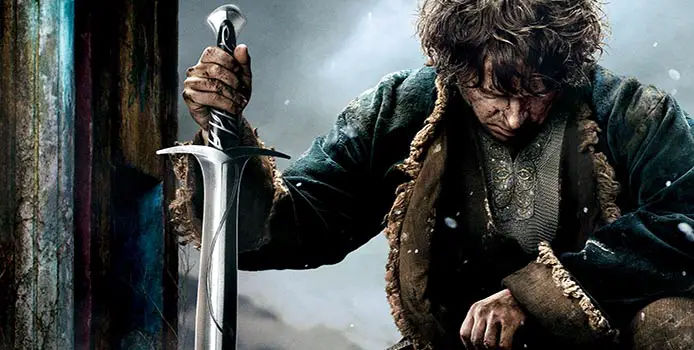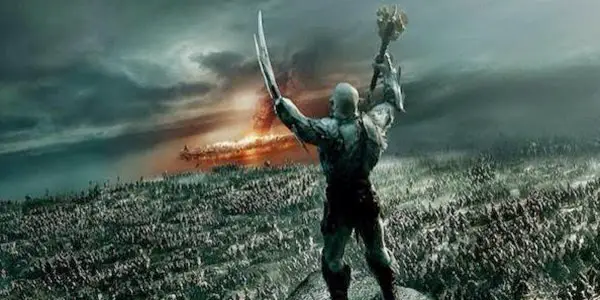THE HOBBIT: THE BATTLE OF THE FIVE ARMIES: A (Mostly) Satisfactory Conclusion To The Trilogy

David is a film aficionado from Colchester, Connecticut. He enjoys…
Peter Jackson‘s first Lord of the Rings trilogy is potentially one of the finest trilogies ever made. Each film in the series, from Fellowship of the Ring to Return of the King, are all solid masterpieces, containing beautiful cinematography, fine character acting, and iconic soundtracks by Howard Shore. The Hobbit series, on the other hand, is much more inconsistent. The first entry, subtitled An Unexpected Journey, was to me a major disappointment. And while Jackson slightly redeemed himself with Desolation of Smaug, it was still just missing that magic touch. The Battle of the Five Armies is a lot more of the same, substituting mindless, even dull action at the expense of character development. That being said, there is just enough here to be passable, and it completes The Hobbit trilogy on a mostly positive note.
Stories fizzle out to be replaced with nothing
The Battle of the Five Armies begins right where the previous film left off, with Smaug (Benedict Cumberbatch, in a snakily sinister voice) fleeing his proud home to proclaim vengeance on the poor nearby village, which unfortunately was just in the wrong place at the wrong time. What follows is what you might expect: homes lit up by dragon fire, buildings collapsing, and terrified villagers fleeing with their lives. It is an exhilaratingly intense scene, which is unfortunately cut short (you can guess what happens). Because, as we know, this is The Battle of the Five Armies, not The Defeat of Smaug. I knew what was coming, having read J.R.R. Tolkien‘s book, but still felt unfulfilled, mainly because this scene had been set up in the last film and we had waited an entire year to see it.

There are several additional scenes which serve almost no purpose to the rest of the movie, and are seemingly thrown in there just because Jackson had to do something to conclude the subplot, even if it never should have been a part of the story. Gandalf (Ian McKellen, who seems to be getting too old for the role) is still imprisoned by the Necromancer, awaiting rescue, which comes in the form of characters we know all too well. The scene is solid enough, with some good action and lead up to The Fellowship of the Ring. But once again, that’s not the point. The point is the Battle, which takes up nearly the remainder of the film.
Epic, but disappointing action
It would be hard to criticize a movie that is brimming with action for not having enough of it. Yet, that’s still one of the issues I had with The Battle of the Five Armies. When the mentioned Five Armies come together, you expect that it will be something outstanding, since it had been building for so long (it is the name of the movie, after all). All that it really did, though, was make me nostalgic for battles in other films such as Helm’s Deep in The Two Towers or Minas Tirith in Return of the King. What made those so memorable was the unexpectedness of it all: the fighting would switch from one front to the next, but would spend just as much time on each to make you invested; the score by Howard Shore was strong, but not invasive; and the connection to individual characters which had been well-shaped beforehand made us even more involved in the outcome of the fight, and even more upset when one of them meets their demise.

Here, though, we find ourselves in the midst of five boring, faceless armies, a couple of which had just been introduced only seconds before. For example, Thorin’s cousin leads an army of dwarves, and this is our first time seeing any of them. How are we supposed to care about these characters when we didn’t even know that they existed before now? The editing of the action scenes is also frustrating, spending only seconds at a time on the main battle, and then nearly 20 minutes on defeating two top bad guys, which once again gives a huge spotlight to Legolas (Orlando Bloom). As you may know, he is not even supposed to be in these movies in the first place, so it doesn’t seem right to give him such a big moment. There should have been much more time spent on Thorin’s dwarves, who are meant to be the focus of the series. But by the end I couldn’t tell you the difference between Bifur, Bofur, Dori, Nori, or many of the others. Only Thorin Oakenshield (Richard Armitage) is given his proper due.
Strong character moments
The strongest moments of The Battle of the Five Armies come away from the battle, when we finally gain more of an insight into at least a few main characters. Bilbo (Martin Freeman), for example, is forced to make a tough decision in order to save the livelihood of the dwarves, even though it may come at the expense of his life. And Thorin is so caught up in his own narcissism that we start to hate him, before he of course gains his own redemption (in a memorable, powerful scene).The two roles are perhaps the most important of the series as a whole, and Freeman and Armitage both give heartfelt, genuine performances.

It seems to be a trend in the series that the best moments come between Bilbo and another main character. For example, Bilbo’s first encounter with Gollum is the highlight of the first Hobbit and his meeting with Smaug is the highlight of the second. Freeman makes Bilbo charming and likable, showing plenty of growth from the start of the series to the end. His performance may even be enough to make me overlook some other rather irritating elements of the movie (the eagles, yet again!).
Although I may have voiced more of my frustrations than my satisfactions with The Battle of the Five Armies, I do still believe that it is a mostly worthwhile conclusion to the series. Judged on its own as just a late-year action film, it is solidly entertaining. It is probably my expectations that are too high, because even ten years later I am still comparing each of the films to the Lord of the Rings series. It’s a different series though, with its own tone, so it would be unfair to judge it to such high standards. And if you go into the film understanding this concept, then you may find that it’s not so bad.
(top image source: Warner Bros. Pictures)
Does content like this matter to you?
Become a Member and support film journalism. Unlock access to all of Film Inquiry`s great articles. Join a community of like-minded readers who are passionate about cinema - get access to our private members Network, give back to independent filmmakers, and more.
David is a film aficionado from Colchester, Connecticut. He enjoys writing, reading, analyzing, and of course, watching movies. His favorite genres are westerns, crime dramas, horror, and sci-fis. He also enjoys binge-watching TV shows on Netflix.













